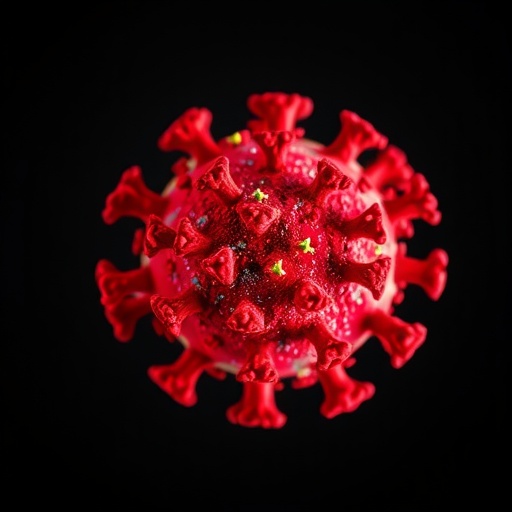A novel study published in BioMedical Engineering OnLine reveals groundbreaking insights into the prolonged effects of COVID-19 on the autonomic regulation of cardiovascular and respiratory functions. Employing a sophisticated model-based spectral directional methodology, researchers have identified persistent alterations in cardiorespiratory control and baroreflex mechanisms in COVID-19 survivors, even nine months post hospital discharge. This investigation sheds new light on the subtle yet enduring disruptions that the virus imparts on the delicate interplay between heart rate, blood pressure, and respiratory rhythm, highlighting implications for patient monitoring and long-term recovery strategies.
The study pivots on a refined analytical technique known as causal squared coherence (CK²), which enables a directional assessment of physiological signals within a closed-loop system. By analyzing beat-to-beat variability in heart period (HP) and systolic arterial pressure (SAP), alongside respiratory activity (RESP), the authors dissect the nuanced dynamics underpinning cardiovascular autonomic control. These complex interactions typically adapt in response to orthostatic challenges such as active standing, yet in COVID-19 patients, expected physiological adaptations appear significantly blunted or absent.
A cohort of COVID-19 survivors, stratified by severity of their respiratory support requirements during hospitalization—ranging from no continuous positive airway pressure (noCPAP) to invasive mechanical ventilation (IMV)—underwent comprehensive cardiorespiratory assessments. The setting involved measurements taken at rest in the supine position and during active standing, conditions that physiologically modulate autonomic outputs via baroreflex adjustments. The meticulous approach allowed for targeted evaluation of directional influences—in particular, the modulation of heart rate by respiratory and blood pressure signals—providing a window into autonomic integrity post-infection.
Classically, the transition from supine to standing induces a characteristic decrease in the coupling strength between heart period and respiratory rhythm, coupled with an amplified baroreflex modulation of heart rate. These dynamics optimize cardiovascular stability against gravitational stress and maintain cerebral perfusion. However, the findings strikingly demonstrated that COVID-19 survivors exhibited a failure to manifest these normative adaptive patterns. The diminished responsiveness spanned all patient categories, suggesting a pervasive autonomic dysregulation unmitigated by disease severity or ventilatory intervention type.
Importantly, the spectral causality markers derived from the CK² approach remained statistically invariant across groups and conditions, underscoring a sustained impairment in the directional neural control pathways long after clinical recovery from the acute viral illness. This persistent autonomic deficit aligns with clinical reports of post-acute sequelae of COVID-19, often characterized by symptoms such as orthostatic intolerance, fatigue, and dysautonomia-like presentations. The current study concretely ties these phenomena to measurable dysfunctions in the cardiorespiratory regulatory network.
From a mechanistic standpoint, the employment of a spectral causal framework transcends traditional correlation-based analyses, as it mathematically disentangles bidirectional influences within physiological feedback loops. This distinction is crucial when evaluating systems like heart rate variability and blood pressure regulation, where feedback and feedforward processes co-exist. By isolating the directionality of interactions, CK² better reflects pathophysiological disruptions affecting autonomic signal processing and integration in COVID-19 convalescents.
The robustness of these findings is amplified by the longitudinal lens of the study, assessing participants nearly a year after hospital discharge. The persistence of cardiorespiratory control anomalies points to potential long-lasting neural plasticity changes or sustained inflammatory sequelae impacting brainstem autonomic centers and peripheral afferent pathways. Elucidating such long-term mechanisms is pivotal for developing targeted rehabilitation and therapeutic interventions aiming to restore autonomic balance.
In parallel, the study’s indication that severity of initial respiratory support does not modulate the degree of autonomic impairment suggests that critical illness markers alone may inadequately predict long-term autonomic outcomes. As such, the use of directional spectral methodologies could augment clinical evaluation by providing objective biomarkers of residual dysfunction irrespective of acute disease course, thereby improving prognostication and tailoring follow-up care.
For clinicians and researchers, these insights herald a shift toward integrating advanced signal processing tools into the cardiovascular and respiratory assessment repertoire. By capturing directional causal dynamics, future diagnostic protocols could enhance sensitivity to early autonomic compromise, enabling preemptive management in populations vulnerable to post-COVID syndromes. Moreover, these techniques might extend beyond COVID-19 to other forms of autonomic neuropathy or dysregulation.
The study also raises intriguing questions about the neurobiological underpinnings linking SARS-CoV-2 infection to chronic autonomic dysregulation. Hypotheses involving viral neurotropism, persistent low-grade inflammation, or autoimmunity-induced neural damage warrant further exploration. Future research integrating imaging, immunological assays, and electrophysiological monitoring could validate and expand upon these causal inferences.
Furthermore, the lack of recovery or adaptation in orthostatic cardiovascular reflexes assessed via directional coherence metrics highlights the potential for long-term health consequences, such as increased risk for syncope, cardiovascular events, or diminished exercise tolerance. Public health strategies must therefore consider the burden of post-COVID autonomic sequelae as a component of pandemic aftermath planning.
In sum, this innovative approach combining model-based spectral causality with physiological stress testing unveils a critical layer of autonomic dysfunction persisting months after acute COVID-19. The research sets a new benchmark for interrogating the neural control of cardiorespiratory systems and underscores the significance of longitudinal, mechanistically-informed studies in understanding and managing the complex aftermath of viral pandemics.
Subject of Research: Long-term effects of COVID-19 on cardiorespiratory control and baroreflex function analyzed through a model-based spectral directional approach.
Article Title: A model-based spectral directional approach reveals the long-term impact of COVID-19 on cardiorespiratory control and baroreflex.
Article References:
Cairo, B., Gelpi, F., Bari, V. et al. A model-based spectral directional approach reveals the long-term impact of COVID-19 on cardiorespiratory control and baroreflex.
BioMed Eng OnLine 24, 8 (2025). https://doi.org/10.1186/s12938-024-01327-8
Image Credits: Scienmag.com




